2000 BMW 328Ci CONVERTIBLE clock
[x] Cancel search: clockPage 10 of 199

Contents
Overview
Controls and features
Cockpit16
Instrument cluster18
Indicator and warning lamps20
Multifunction steering wheel
(MFL)24
Hazard warning flashers25
Warning triangle25
First-aid kit25
Refueling26
Fuel specifications27
Tire inflation pressure27
Opening and closing:
Keys32
Electronic vehicle
immobilizer33
Central locking system34
Opening and closing – from
outside34
Opening and closing – from
inside38
Luggage compartment lid39
Luggage compartment40
Alarm system42
Electric power windows44
Manual convertible top45
The fully automatic convertible
top49
Wind deflector51
Adjustments:
Seats53
Seat and mirror memory57
Steering wheel58
Mirrors58
Car Memory, Key Memory60
Passenger safety systems:
Safety belts61
ISOFIX Attachment of the
child seat62
Airbags63
Child restraints66
Installing a child restraint
system67
Rollover protection system68
Driving:
Steering/Ignition lock70
Starting the engine70
Switch off the engine71
Parking brake72
Manual transmission73
Automatic transmission with
Steptronic74
Turn signal indicator/
Headlamp flasher77
Washer/Wiper system/
Rain sensor77
Rear window defroster79
Cruise control80
Everything under control:
Odometer82
Tachometer82
Energy Control82
Fuel gauge83
Coolant temperature gauge83
Service Interval Display83
Check Control84
Clock84
Onboard computer85
Technology for safety and
driving convenience:
Park Distance Control (PDC)87
Dynamic Stability Control
(DSC)88
Tire Pressure Control (RDC)89
Contents
Page 19 of 199
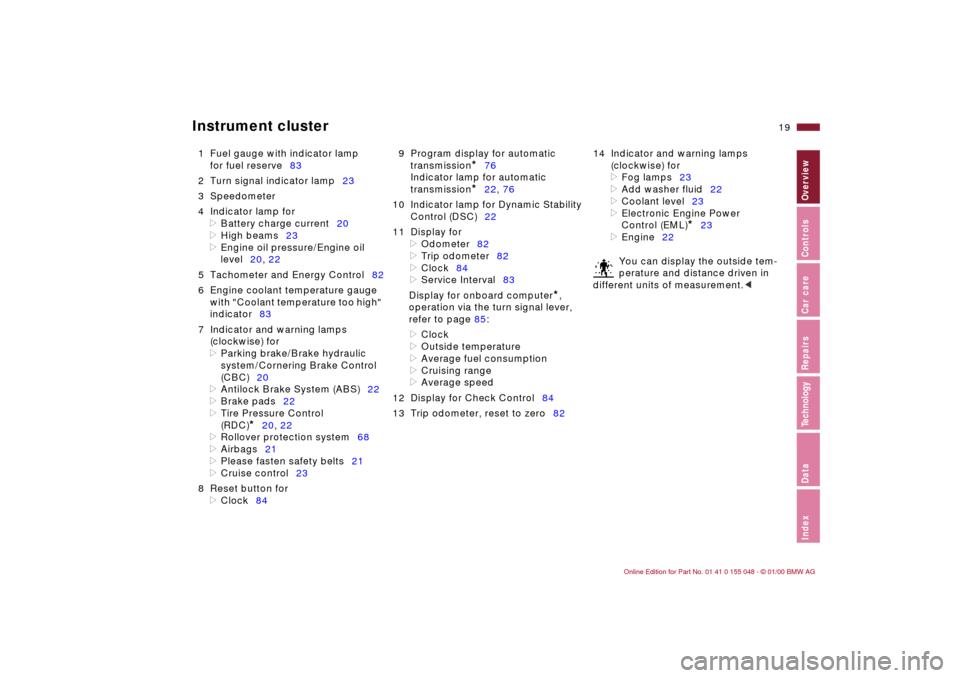
19n
IndexDataTechnologyRepairsCar careControlsOverview
Instrument cluster
1 Fuel gauge with indicator lamp
for fuel reserve83
2 Turn signal indicator lamp23
3 Speedometer
4 Indicator lamp for
>
Battery charge current20
>
High beams23
>
Engine oil pressure/Engine oil
level20, 22
5 Tachometer and Energy Control82
6 Engine coolant temperature gauge
with "Coolant temperature too high"
indicator83
7 Indicator and warning lamps
(clockwise) for
>
Parking brake/Brake hydraulic
system/Cornering Brake Control
(CBC)20
>
Antilock Brake System (ABS)22
>
Brake pads22
>
Tire Pressure Control
(RDC)
*
20, 22
>
Rollover protection system68
>
Airbags21
>
Please fasten safety belts21
>
Cruise control23
8 Reset button for
>
Clock849 Program display for automatic
transmission
*
76
Indicator lamp for automatic
transmission
*
22, 76
10 Indicator lamp for Dynamic Stability
Control (DSC)22
11 Display for
>
Odometer82
>
Trip odometer82
>
Clock84
>
Service Interval83
Display for onboard computer
*
,
operation via the turn signal lever,
refer to page 85:
>
Clock
>
Outside temperature
>
Average fuel consumption
>
Cruising range
>
Average speed
12 Display for Check Control84
13 Trip odometer, reset to zero8214 Indicator and warning lamps
(clockwise) for
>
Fog lamps23
>
Add washer fluid22
>
Coolant level23
>
Electronic Engine Power
Control (EML)
*
23
>
Engine22
You can display the outside tem-
perature and distance driven in
different units of measurement.
<
Page 31 of 199

Overview
Controls and features
Operation, care
and maintenance
Owner service procedures
Technical data
Index Advanced technology
31n
IndexDataTechnologyRepairsCar careControlsOverview
Driving:
Steering/Ignition lock70
Starting the engine70
Switching off the engine71
Parking brake72
Manual transmission73
Automatic transmission with
Steptronic74
Turn signal indicator/Headlamp
flasher77
Washer/Wiper system/
Rain sensor77
Rear window defroster79
Cruise control80
Everything under control:
Odometer82
Tachometer82
Energy Control82
Fuel gauge83
Coolant temperature gauge83
Service Interval Display83
Check Control84
Clock84
Onboard computer85
Technology for safety and
convenience:
Park Distance Control (PDC)87
Dynamic Stability Control
(DSC)88
Tire Pressure Control (RDC)89Lamps:
Parking lamps/Low beams91
Instrument lighting91
High beams/Parking lamps92
Fog lamps92
Interior lamps92
Reading lamps93
Controlling the climate for
pleasant driving:
Automatic climate control94
Seat heating99
Cabin conveniences:
Glove compartment99
BMW Universal
Transmitter *100
Storage compartments102
Cellular phone103
Ashtray front103
Cigarette lighter104
Ashtray rear104
Loading and transporting:
Ski bag105
Cargo loading106
Luggage rack for the
hardtop108
Page 64 of 199
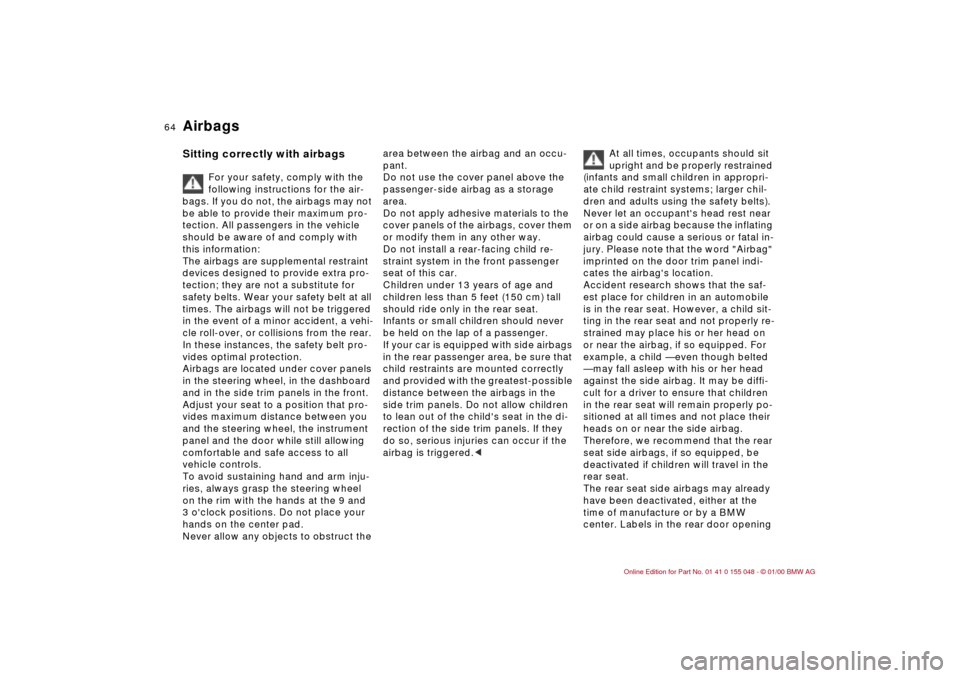
64n
AirbagsSitting correctly with airbags
For your safety, comply with the
following instructions for the air-
bags. If you do not, the airbags may not
be able to provide their maximum pro-
tection. All passengers in the vehicle
should be aware of and comply with
this information:
The airbags are supplemental restraint
devices designed to provide extra pro-
tection; they are not a substitute for
safety belts. Wear your safety belt at all
times. The airbags will not be triggered
in the event of a minor accident, a vehi-
cle roll-over, or collisions from the rear.
In these instances, the safety belt pro-
vides optimal protection.
Airbags are located under cover panels
in the steering wheel, in the dashboard
and in the side trim panels in the front.
Adjust your seat to a position that pro-
vides maximum distance between you
and the steering wheel, the instrument
panel and the door while still allowing
comfortable and safe access to all
vehicle controls.
To avoid sustaining hand and arm inju-
ries, always grasp the steering wheel
on the rim with the hands at the 9 and
3 o'clock positions. Do not place your
hands on the center pad.
Never allow any objects to obstruct the
area between the airbag and an occu-
pant.
Do not use the cover panel above the
passenger-side airbag as a storage
area.
Do not apply adhesive materials to the
cover panels of the airbags, cover them
or modify them in any other way.
Do not install a rear-facing child re-
straint system in the front passenger
seat of this car.
Children under 13 years of age and
children less than 5 feet (150 cm) tall
should ride only in the rear seat.
Infants or small children should never
be held on the lap of a passenger.
If your car is equipped with side airbags
in the rear passenger area, be sure that
child restraints are mounted correctly
and provided with the greatest-possible
distance between the airbags in the
side trim panels. Do not allow children
to lean out of the child's seat in the di-
rection of the side trim panels. If they
do so, serious injuries can occur if the
airbag is triggered.
(infants and small children in appropri-
ate child restraint systems; larger chil-
dren and adults using the safety belts).
Never let an occupant's head rest near
or on a side airbag because the inflating
airbag could cause a serious or fatal in-
jury. Please note that the word "Airbag"
imprinted on the door trim panel indi-
cates the airbag's location.
Accident research shows that the saf-
est place for children in an automobile
is in the rear seat. However, a child sit-
ting in the rear seat and not properly re-
strained may place his or her head on
or near the airbag, if so equipped. For
example, a child — even though belted
— may fall asleep with his or her head
against the side airbag. It may be diffi-
cult for a driver to ensure that children
in the rear seat will remain properly po-
sitioned at all times and not place their
heads on or near the side airbag.
Therefore, we recommend that the rear
seat side airbags, if so equipped, be
deactivated if children will travel in the
rear seat.
The rear seat side airbags may already
have been deactivated, either at the
time of manufacture or by a BMW
center. Labels in the rear door opening
Page 84 of 199
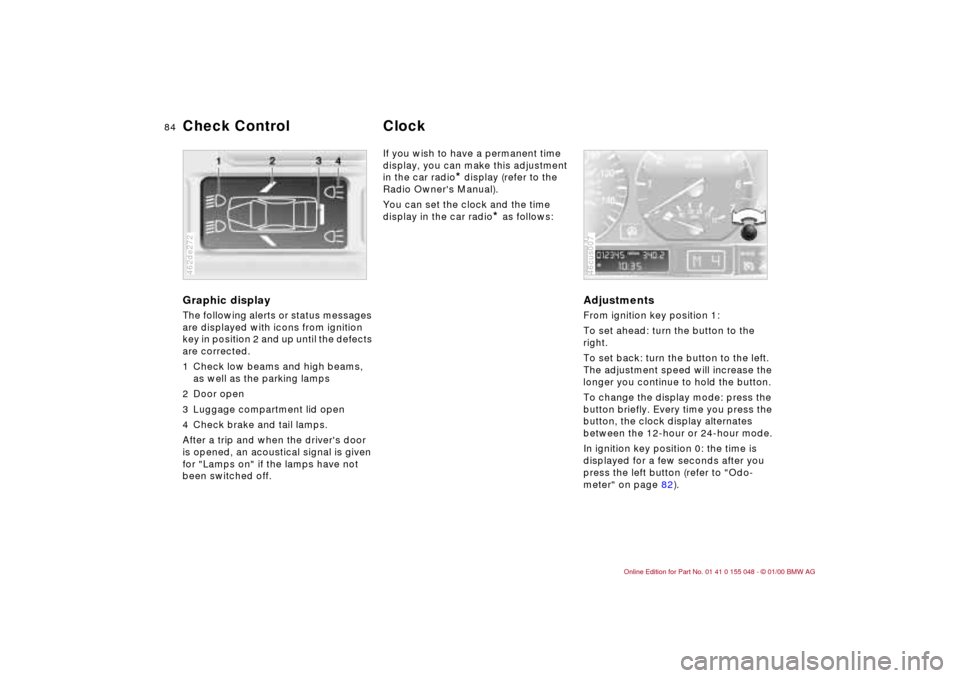
84n
Graphic display
The following alerts or status messages
are displayed with icons from ignition
key in position 2 and up until the defects
are corrected.
1 Check low beams and high beams,
as well as the parking lamps
2 Door open
3 Luggage compartment lid open
4 Check brake and tail lamps.
After a trip and when the driver's door
is opened, an acoustical signal is given
for "Lamps on" if the lamps have not
been switched off.462de272
If you wish to have a permanent time
display, you can make this adjustment
in the car radio
* display (refer to the
Radio Owner's Manual).
You can set the clock and the time
display in the car radio
* as follows:
Adjustments From ignition key position 1:
To set ahead: turn the button to the
right.
To set back: turn the button to the left.
The adjustment speed will increase the
longer you continue to hold the button.
To change the display mode: press the
button briefly. Every time you press the
button, the clock display alternates
between the 12-hour or 24-hour mode.
In ignition key position 0: the time is
displayed for a few seconds after you
press the left button (refer to "Odo-
meter" on page 82).46cus007
Check Control
Clock
Page 136 of 199
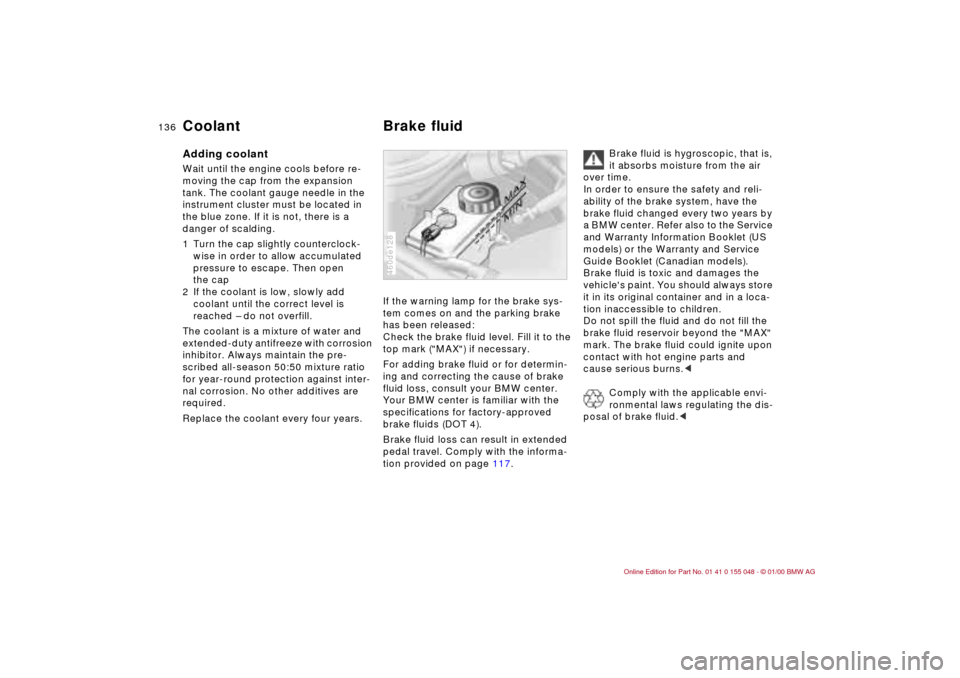
136n
Coolant Brake fluidAdding coolant Wait until the engine cools before re-
moving the cap from the expansion
tank. The coolant gauge needle in the
instrument cluster must be located in
the blue zone. If it is not, there is a
danger of scalding.
1 Turn the cap slightly counterclock-
wise in order to allow accumulated
pressure to escape. Then open
the cap
2 If the coolant is low, slowly add
coolant until the correct level is
reached – do not overfill.
The coolant is a mixture of water and
extended-duty antifreeze with corrosion
inhibitor. Always maintain the pre-
scribed all-season 50:50 mixture ratio
for year-round protection against inter-
nal corrosion. No other additives are
required.
Replace the coolant every four years.If the warning lamp for the brake sys-
tem comes on and the parking brake
has been released:
Check the brake fluid level. Fill it to the
top mark ("MAX") if necessary.
For adding brake fluid or for determin-
ing and correcting the cause of brake
fluid loss, consult your BMW center.
Your BMW center is familiar with the
specifications for factory-approved
brake fluids (DOT 4).
Brake fluid loss can result in extended
pedal travel. Comply with the informa-
tion provided on page 117.
460de128
Brake fluid is hygroscopic, that is,
it absorbs moisture from the air
over time.
In order to ensure the safety and reli-
ability of the brake system, have the
brake fluid changed every two years by
a BMW center. Refer also to the Service
and Warranty Information Booklet (US
models) or the Warranty and Service
Guide Booklet (Canadian models).
Brake fluid is toxic and damages the
vehicle's paint. You should always store
it in its original container and in a loca-
tion inaccessible to children.
Do not spill the fluid and do not fill the
brake fluid reservoir beyond the "MAX"
mark. The brake fluid could ignite upon
contact with hot engine parts and
cause serious burns.<
Comply with the applicable envi-
ronmental laws regulating the dis-
posal of brake fluid.<
Page 162 of 199
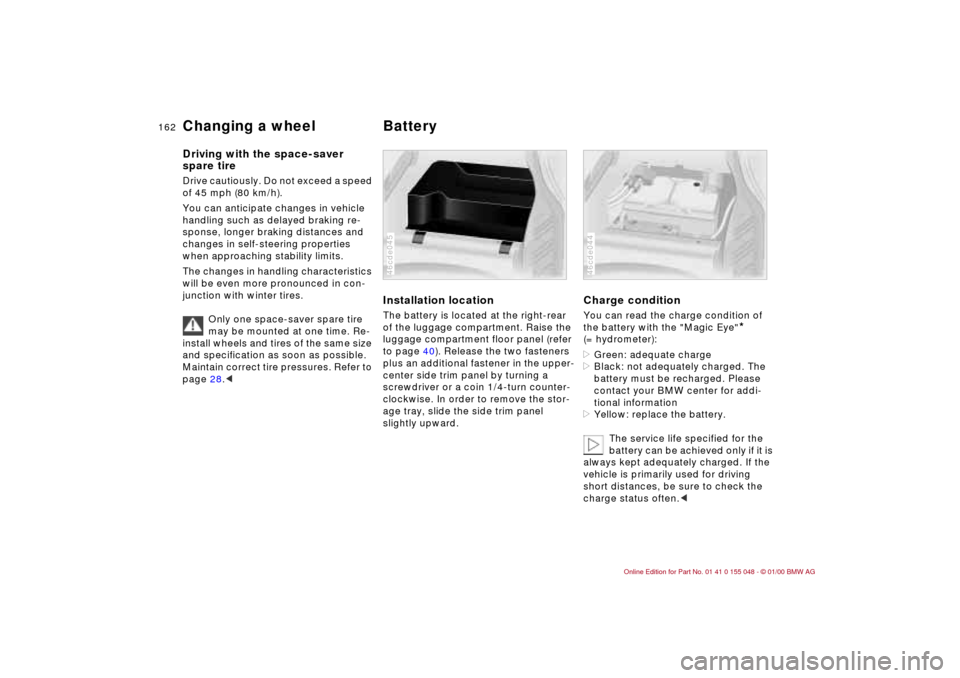
162n
Changing a wheel Battery Driving with the space-saver
spare tireDrive cautiously. Do not exceed a speed
of 45 mph (80 km/h).
You can anticipate changes in vehicle
handling such as delayed braking re-
sponse, longer braking distances and
changes in self-steering properties
when approaching stability limits.
The changes in handling characteristics
will be even more pronounced in con-
junction with winter tires.
Only one space-saver spare tire
may be mounted at one time. Re-
install wheels and tires of the same size
and specification as soon as possible.
Maintain correct tire pressures. Refer to
page 28.<
Installation locationThe battery is located at the right-rear
of the luggage compartment. Raise the
luggage compartment floor panel (refer
to page 40). Release the two fasteners
plus an additional fastener in the upper-
center side trim panel by turning a
screwdriver or a coin 1/4-turn counter-
clockwise. In order to remove the stor-
age tray, slide the side trim panel
slightly upward.46cde045
Charge conditionYou can read the charge condition of
the battery with the "Magic Eye"
*
(= hydrometer):
>Green: adequate charge
>Black: not adequately charged. The
battery must be recharged. Please
contact your BMW center for addi-
tional information
>Yellow: replace the battery.
The service life specified for the
battery can be achieved only if it is
always kept adequately charged. If the
vehicle is primarily used for driving
short distances, be sure to check the
charge status often.<
46cde044
Page 191 of 199

Everything from A to Z
191n
IndexDataTechnologyRepairsCar careControlsOverview
Cigarette lighter104
Clock84
Cockpit16
Code, refer to the Radio
Owner's Manual
Coin box, cup holder103
Combination switch77
Compression182
Computer85
Configure settings60
Consumption86
Consumption display83
Convertible top
care144
electrical defect166
Convertible top
compartment panel41
Convertible top operation,
fully automatic convertible
top49
Coolant118, 135, 185
antifreeze118
Coolant temperature
gauge83
Cooling system185
Cornering Brake Control
(CBC)21, 115
Cruise control80
Cruising range86
Curb weight184
Current check indicator20
DDash lighting91
Dashboard16
Data
dimensions183
engine182
technical182
weights184
Daytime-driving lamp
switch91
Defrost setting97
Defrosting the
windows97, 98
Digital clock84
Dimensions183
Dipstick, engine oil133
Disc brakes116
Displacement182
Display lighting91
Displays18
Distance warning87
Diversity Antenna174
Door key32
Door locks, care118
Doors
emergency actuation34
remote control35
unlocking and locking34
Drive belts186
Driving hints113
Driving in winter118Driving lamps91
DSC (Dynamic Stability
Control)22, 88, 173
EElectric power windows44
Electrical accessories,
failure165
Electrical system186
Electronic vehicle
immobilizer33
Elements of operation16
Emergency actuation
doors34
fuel filler door165
fully automatic convertible
top166
Emergency closure166
Energy Control82
Engine compartment130
Engine coolant135, 185
Engine data182
Engine oil
capacity185
consumption133
pressure20
quality134
specifications134
viscosity134
Engine oil level21
check133Engine speed182
Engine, starting70
Entry to the rear56
Exterior mirrors58
Eyes169
FFailure messages84
Fault displays84
Fault, ABS115
Filler cap cover26
Filling capacities185
Filling the washer
reservoir185
First-aid kit25
Flashlight99
Flat tire123, 159
Fog lamps92
bulb replacement155
"Follow-Me-Home"
lamps91
Footbrake116
Footwell lamps92
bulb replacement158
Front seat adjustment53
Frost protection,
radiator135
Fuel27
gauge83
preparation182
quality27
Fuel consumption86